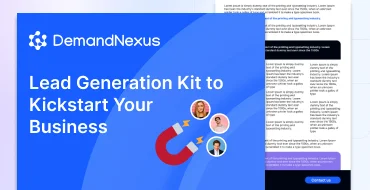Account-based marketing (ABM) is revolutionizing how B2B companies drive revenue by focusing laser-sharp attention on high-value accounts. Unlike broad demand generation or inbound marketing, ABM flips the funnel, targeting specific accounts with personalized campaigns tailored to their unique needs. Recognized by industry leaders like Forrester Wave and Gartner as a top B2B strategy, ABM aligns sales and marketing to deliver measurable results. This comprehensive guide dives into what ABM is, how to implement it, key frameworks, and essential tools like Salesforce, Marketo, and HubSpot, complete with a case study showcasing how
DemandNexus powers success.
What Is Account-Based Marketing (ABM)?
Account-based marketing (ABM) is a strategic B2B approach that concentrates resources on a select group of high-potential accounts, treating each as a market of one. Instead of casting a wide net to generate leads, ABM uses personalized campaigns—leveraging digital channels, email, LinkedIn, and programmatic ads—to engage key stakeholders with content and messaging tailored to their specific challenges and goals. ABM goes beyond lead generation, fostering deeper relationships to drive conversions, upsells, and retention.
ABM aligns closely with the customer journey, ensuring every touchpoint, from awareness to advocacy, is customized. Industry reports, like the Forrester Wave, highlight ABM’s ability to deliver higher ROI compared to traditional tactics, making it a cornerstone of modern
B2B demand generation.
Benefits of Account-Based Marketing
ABM offers distinct advantages for B2B companies targeting enterprises or high-value accounts. Here’s why it’s a game-changer:
- Personalized Engagement: ABM delivers bespoke experiences, with 71% of buyers expecting tailored interactions, per McKinsey.
- Sales and Marketing Alignment: Unites teams to focus on shared goals, streamlining the funnel and boosting efficiency.
- Shorter Sales Cycles: By engaging multiple stakeholders simultaneously, ABM can reduce cycle times by up to 30%, according to Cyance.
- Higher ROI: Demand Metric reports 19% of ABM adopters see 30% revenue growth within a year.
- Resource Efficiency: Targets only high-fit accounts, minimizing wasted efforts on low-value leads.
ABM vs. Traditional Marketing: A Comparison
ABM differs significantly from inbound marketing and demand generation. Here’s how:
| Aspect |
ABM |
Inbound/Demand Generation |
| Focus |
Specific high-value accounts |
Broad audience |
| Approach |
Personalized, account-specific campaigns |
Generalized content to attract leads |
| Funnel |
Account-centric, multi-stakeholder |
Lead-centric, linear |
| Channels |
LinkedIn, email, programmatic ads |
SEO, blogs, social media |
How to Implement an ABM Strategy: A Step-by-Step Playbook
Building a successful ABM program requires a structured approach. Follow this playbook to create a high-impact strategy:
1. Identify High-Value Target Accounts
Start by defining your Ideal Customer Profile (ICP) based on firmographic data like industry, revenue, and company size. Use tools like Salesforce or
lead research services to pinpoint accounts with the highest revenue potential. Segment accounts into tiers (e.g., 1:1, 1:Few, 1:Many) to allocate resources effectively.
2. Research and Map the Customer Journey
Deeply understand each account’s pain points, decision-makers, and buying process. Leverage intent data from platforms like Terminus to identify accounts showing interest. Map the customer journey to tailor content for each stage—awareness, consideration, decision, and advocacy.
3. Develop Personalized Campaigns
Create customized content and campaigns for each account. Use a mix of channels:
- Email: Craft tailored cold email sequences addressing specific challenges.
- LinkedIn: Run targeted ads or InMail campaigns to engage stakeholders.
- Programmatic Ads: Use IP targeting to deliver account-specific banners.
- Webinars: Host account-focused sessions, as BrightTalk reports 97% of buyers prefer webinars for vendor learning.
4. Align Sales and Marketing
Ensure sales and marketing collaborate seamlessly. Use a shared dashboard in HubSpot or Salesforce to track account progress. Equip sales teams with enablement content, like case studies or pitch decks, to support personalized outreach.
5. Execute and Optimize
Launch campaigns across chosen channels, ensuring consistent messaging. Use A/B testing to refine emails or ad creatives. Monitor performance with a dashboard tracking KPIs like engagement and pipeline influence, and iterate based on data.
ABM Framework: Structuring Your Approach
An ABM framework provides a structured model to guide your strategy. Here’s a simple framework inspired by industry leaders like Gartner:
- Account Selection: Use data to choose high-fit accounts.
- Insight Gathering: Research account needs and stakeholders.
- Content Personalization: Create tailored assets for each account.
- Multi-Channel Engagement: Deploy campaigns across email, LinkedIn, and ads.
- Measurement: Track KPIs to assess impact and optimize.
Visualize this framework with an infographic or diagram to align teams. For example, a funnel diagram can illustrate how accounts move from targeting to conversion.

Key Tools for ABM Success
ABM thrives on technology to scale personalization and track performance. Here are essential tools:
| Tool |
Purpose |
Example |
| CRM |
Manage account data and interactions |
Salesforce |
| Marketing Automation |
Personalize and automate campaigns |
Marketo |
| ABM Platform |
Orchestrate account-specific campaigns |
Terminus |
| Social Selling |
Engage stakeholders on social |
LinkedIn Sales Navigator |
| Analytics |
Track KPIs and engagement |
HubSpot |
ABM Metrics and KPIs
Measuring ABM success requires focusing on account-centric metrics. Key KPIs include:
| Metric |
Formula |
Why It Matters |
| Account Engagement |
Interactions per account (clicks, views) |
Shows campaign resonance |
| Pipeline Influence |
Revenue attributed to ABM campaigns |
Links ABM to revenue |
| Win Rate |
(Closed-Won Deals / Total Opportunities) * 100 |
Measures conversion success |
| Customer Acquisition Cost (CAC) |
(Marketing + Sales Costs) / New Customers |
Assesses efficiency |
Use dashboards in tools like Salesforce or
ABM metrics platforms to visualize these KPIs and optimize campaigns.
Case Study: DemandNexus Drives ABM Success for a SaaS Provider
A mid-sized SaaS company offering cybersecurity solutions struggled to penetrate enterprise accounts, with only 10% of leads converting to opportunities.
DemandNexus stepped in to implement a robust ABM strategy.
- Challenge: Low engagement with enterprise decision-makers and lengthy sales cycles.
- Solution: DemandNexus used Terminus to identify 20 high-value accounts and crafted personalized campaigns, including LinkedIn InMail, lead nurturing emails, and account-specific webinars. They also integrated Salesforce for real-time tracking.
- Results: Engagement rates rose to 65%, opportunities increased by 40%, and the sales cycle shortened by 25% within six months.
DemandNexus’s expertise in ABM, backed by tailored
lead generation services, helps B2B companies target and convert high-value accounts efficiently.
ABM Campaign Examples and Tactics
Effective ABM campaigns leverage multiple channels to engage accounts. Here are proven tactics:
- Personalized Emails: Use Marketo to send tailored sequences addressing account-specific pain points.
- LinkedIn Ads: Target stakeholders with account-specific ads, as Cognism did with its cupcake campaign, achieving 80% response rates.
- Direct Mail: Send high-value gifts to key decision-makers, enhancing memorability.
- Web Personalization: Customize landing pages with account-specific content, boosting conversions.
Overcoming ABM Challenges
ABM isn’t without hurdles. Here’s how to address common issues:
- Data Quality: Use platforms like Terminus for accurate intent data to target the right accounts.
- Scalability: Start with 1:Few ABM (10-50 accounts) to test and scale gradually.
- Alignment: Hold regular sales-marketing syncs to maintain focus on shared goals.
Your ABM Plan: Getting Started
Account-based marketing transforms B2B growth by targeting high-value accounts with precision. Begin by selecting accounts that align with your ICP, then craft personalized campaigns across email, LinkedIn, and programmatic channels. Use tools like Salesforce, Marketo, and HubSpot to scale efforts and track KPIs. With a clear framework and data-driven iteration, ABM can deliver unmatched ROI.
Ready to supercharge your ABM strategy?
DemandNexus offers expert ABM solutions, from account selection to campaign execution, to drive B2B revenue. Contact them today to build a playbook that wins high-value accounts.





